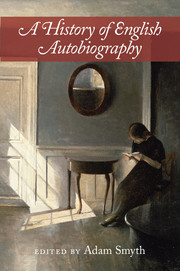Book contents
- Frontmatter
- Dedication
- Contents
- List of contributors
- 1 Introduction: The range, limits, and potentials of the form
- PART 1 AUTOBIOGRAPHY BEFORE ‘AUTOBIOGRAPHY’ (CA. 1300–1700)
- PART 2 RELIGION, GENDER, THINGS (CA. 1700–1800)
- PART 3 THE MANY NINETEENTH CENTURIES (CA. 1800–1900)
- PART 4 RELATIONAL LIVES AND FORMS OF REMEMBERING (CA. 1890–1930)
- 18 ‘Fusions and interrelations’: Family memoirs of Henry James, Edmund Gosse, and others
- 19 Queer lives: Wilde, Sackville-West, and Woolf
- 20 Anecdotal remembrance: Forms of First and Second World War life-writing
- 21 Experiments in form: Modernism and autobiography in Woolf, Eliot, Mansfield, Lawrence, Joyce, and Richardson
- 22 Psychoanalysis and autobiography
- PART 5 KINDS OF COMMUNITY (CA. 1930-CONTEMPORARY)
- Index
- References
19 - Queer lives: Wilde, Sackville-West, and Woolf
from PART 4 - RELATIONAL LIVES AND FORMS OF REMEMBERING (CA. 1890–1930)
Published online by Cambridge University Press: 05 March 2016
- Frontmatter
- Dedication
- Contents
- List of contributors
- 1 Introduction: The range, limits, and potentials of the form
- PART 1 AUTOBIOGRAPHY BEFORE ‘AUTOBIOGRAPHY’ (CA. 1300–1700)
- PART 2 RELIGION, GENDER, THINGS (CA. 1700–1800)
- PART 3 THE MANY NINETEENTH CENTURIES (CA. 1800–1900)
- PART 4 RELATIONAL LIVES AND FORMS OF REMEMBERING (CA. 1890–1930)
- 18 ‘Fusions and interrelations’: Family memoirs of Henry James, Edmund Gosse, and others
- 19 Queer lives: Wilde, Sackville-West, and Woolf
- 20 Anecdotal remembrance: Forms of First and Second World War life-writing
- 21 Experiments in form: Modernism and autobiography in Woolf, Eliot, Mansfield, Lawrence, Joyce, and Richardson
- 22 Psychoanalysis and autobiography
- PART 5 KINDS OF COMMUNITY (CA. 1930-CONTEMPORARY)
- Index
- References
Summary
Readings of modernist queer autobiography have usefully shown that queer life-writings differ from straight autobiographies through coding and masking, a technique that sometimes produces two readers: those in the know, and those with no clue (Gilmore 1991; Loftus 1997; Stimpson 1992; Watson 1992). The focus of this chapter, however, is not to show that modernist queer autobiography is or is not modelled after a heterosexual text, using codes and masks for expression within an expected straight form of a life. Instead, if we turn from the concern of many critics that queer autobiography cannot be expressed, imagined, or read, if we set aside a focus on how queer autobiography differs from straight because of inability to signify – if, instead, we focus on the historical emergence of same-sex representation in autobiography and recognise it as part of a developing Western autobiographical discourse, then the modernist site of autobiography explodes with an awareness of how queer turn-of-the-century (nineteenth to twentieth) autobiography foregrounds a form of textual representation in the genre hitherto unrecognised as such. One might label this evocative formation as meta-autobiography, since this development consists of a self-reflexive critique of ideologies that seemingly require heteronormative and masculine subjectivities and scripts as necessary in the representation of an autobiographical ‘I’ (Jelinek 1986; Heilbrun 1988; Loftus 1997; Watson 1992).
This chapter, then, recognises as historical the mutations of the genre that queer autobiography develops. It explores the critiques of modernist cultures as they are couched in representations of same-sex sexuality. Specifically, the modernist autobiographies I read critique the cultures surrounding phrenology, criminality and censorship, and sex/gender systems. Autobiographies that write same-sex desires into their texts in this period critique cultural contexts by recasting a relation between textual representation and experience. That recasting side-steps a (heteronormative) ideology of truth as factual, instead presenting truth as culturally determined and prejudicial. The signifier–signified representation of the writing and written ‘I’ is newly conceived, while the autobiographies attack societies that require individuals to conform within a recently-codified sex-gender system.
Oscar Wilde's pose
Oscar Wilde uses queer life-writing in the public sphere to comment upon cultural morays. From his novel The Portrait of Dorian Gray through the notorious trials (1895) and to the subsequent autobiography De Profundis, Wilde repositions the ‘I’ and the body as they interface with his public.
- Type
- Chapter
- Information
- A History of English Autobiography , pp. 269 - 283Publisher: Cambridge University PressPrint publication year: 2016



